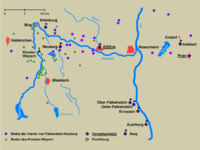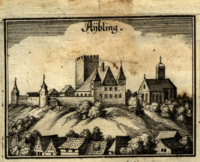- Counts of Falkenstein (Bavaria)
-
The counts of Falkenstein (from 1125 referred to as counts of Falkenstein-Neuburg) were Bavarian nobility. In the time of the House of Hohenstaufen they were among the most influential dynasties.
Contents
Dominion
The counts of Falkenstein had their oldest possessions in the upper Vils valley near Taufkirchen (Vils) and the valley of Inn in southern Bavaria. In the zenith of their power they controlled a wide region extending into Tyrol, the Mangfall valley, Lower Austria and Chiemgau.
Major domiciles of the counts of Falkenstein were Falkenstein über dem Inn, Neuburg bei Vagen, Altenburg, Herantstein in Upper Austria, Hartmannsberg near Hemhof, Antwurt (now Antwort) near Endorf and Hernstein near Baden in Lower Austria. Administrative towns were e.g. Aibling and Prien am Chiemsee.
History
The allodial possessions of the Falkensteiners were in Geiselbach in the upper Vils valley. The first count of Falkenstein mentioned in records was Reginolt de Valchensteine (1115), although both the Falkensteiner and Neuburger lineage seem to descend from Patto von Dilching (early 11th century)[1].
The counts of Falkenstein rapidly extended their influence. By marriage they merged with the counts of Weyarn-Neuburg in 1125. In 1133 they founded the monastery of Weyarn.
After the deposition of Henry the Lion, when the bavarian dukedom was transferred to Otto I of Wittelsbach the Falkensteiners allied with the enemies of the Wittelbachers. This marked the beginning of the forced decline of the dynasty of Falkenstein.
The Falkensteiner lineage perished with the assassination of the last counts of Falkenstein in the 13th century.
Codex Falkensteinensis
Being known as the oldest feud directory and urbar, the Codex Falkensteinensis is considered as the only conserved tradition book of a secular authority. It was created in 1170 at the Falkensteiner Neuburg near Vagen.
References
- ^ J. B. Freed, The Counts of Falkenstein: Noble Self-Consciousness in Twelfth-Century Germany. The American Philosophical Society, Philadelphia 1984, ISBN 0871697467
Categories:- German nobility
- German noble families
- History of Bavaria
Wikimedia Foundation. 2010.


